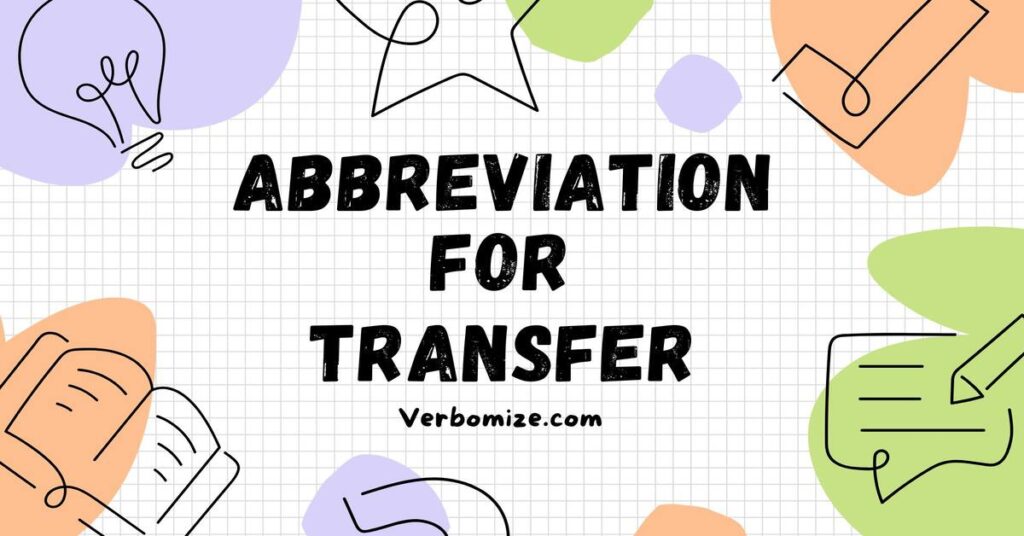Looking for the abbreviation for transfer? You’re not alone! Whether you’re dealing with banking, education, or even business, this simple term pops up in all sorts of situations. Understanding this abbreviation can save you time and make communication smoother, but knowing when and where to use it is key.
In this article, we’ll dive into what it means, where it’s commonly used, and why it matters. You’ll quickly see how mastering this abbreviation can make your life just a little bit easier. Ready to get started? Let’s break it down!
What is the Abbreviation for Transfer?
The abbreviation for transfer is TRANSF. It’s the shortened form of the word transfer, used to save time and space, especially in industries where the term is frequently mentioned. By condensing transfer into TRANSF, communication becomes more efficient, whether it’s in banking, logistics, or education.
Why Do We Use the Short Form of Transfer?
Abbreviations, such as the transfer short form, are often used in professional environments for several reasons:
- Efficiency: Using abbreviations reduces the time spent writing or typing the word repeatedly.
- Clarity: In documents, the shortened form of transfer makes information quicker to process.
- Space-saving: Especially in tables, reports, or forms, transfer in short form ensures documents remain concise and organized.
What Does the Transfer Short Form or TRANSF Mean?
The transfer abbreviation in banking is one of the most commonly encountered contexts for TRANSF. It represents the process of transferring funds, assets, or information from one entity to another. Here’s how TRANSFER is used in different industries:
In Banking:
- Abbreviation for transfer in banking: TRANSF refers to the movement of funds between accounts or institutions. For example, “bank TRANSF” could be used in a document to describe a bank transfer.
In Education:
- Credit TRANSF or student TRANSF refers to transferring students or academic credits from one institution to another.
In Logistics:
- Inventory TRANSF or goods TRANSF describes the act of moving products from one location to another.
In Technology:
- Data TRANSF refers to the transfer of data from one system to another, commonly seen with terms like FTP (File Transfer Protocol).
The transfer abbreviation becomes especially useful when these processes are frequently mentioned in documents and communication, making the message clearer and more concise.
Understanding the Term “Transfer”: Definition & Pronunciation
Before delving deeper into the abbreviation TRANSF, it’s important to understand the transfer concept itself. Whether it’s moving money, shifting goods, or relocating students, transfer refers to the act of moving something from one place to another.
Pronunciation of TRANSFER:
- Transfer is pronounced as /ˈtræns-fər/ in English. The key syllables are “trans” (rhymes with “pants”) and “fer” (with a soft “r”).
The pronunciation remains similar for the transfer shorthand, TRANSF, though in fast speech, the last syllable might be omitted.
Why Use the Transfer Abbreviation?
The short form of transfer is an efficient tool, particularly in environments where quick communication is essential. Professionals in finance, logistics, and education often prefer TRANSF to save time, especially in fast-paced transactions, academic reports, or business communications.
Benefits of Using TRANSFER Short Form:
- Speed: In finance, transfers happen quickly. Using TRANSF instead of the full word helps speed up communication.
- Professionalism: In documents like contracts, emails, and reports, using the acronym for transfer (like TRANSF) maintains clarity and reduces redundancy.
- Space: Forms, tables, and graphs benefit from using transfer shortened, as it prevents clutter and helps fit more information in less space.
Real-Life Examples: How “Transfer” and “TRANSF” Are Used
Let’s take a look at how transfer and its shorthand TRANSF are applied in the real world.
Banking:
- Bank Transfer → Bank TRANSF: Referring to the movement of money between accounts.
- Wire Transfer → Wire TRANSF: The electronic transfer of funds.
Education:
- Student Transfer → Student TRANSF: Refers to transferring students between schools or universities.
- Credit Transfer → Credit TRANSF: Describes the process of transferring academic credits.
Logistics:
- Inventory Transfer → Inventory TRANSF: The movement of stock between warehouses or locations.
- Goods Transfer → Goods TRANSF: Referring to the shipping or transportation of goods.
In each case, using the transfer abbreviation like TRANSF makes communication more efficient without losing the meaning or context.
Short Form of Transfer in Various Contexts
While TRANSF is the most widely accepted transfer acronym, there are other forms used in specific contexts:
| Industry | Abbreviation | Meaning |
|---|---|---|
| Banking | MT | Money Transfer |
| Logistics | XFR | Transfer of Goods or Inventory |
| Technology | FTP | File Transfer Protocol |
| Education | CT | Credit Transfer |
These different transfer short forms help professionals stay concise and ensure clarity across industries.
Broader Context: Related Acronyms and Terms Involving “Transfer”
Other acronyms and abbreviations related to TRANSFER are used in similar or connected contexts. Here are a few:
- SWIFT: Society for Worldwide Interbank Financial Telecommunication (used for international transfers in finance).
- FTP: File Transfer Protocol (used in technology for transferring data between systems).
- MT: Money Transfer (another way to abbreviate transfer in the financial world).
Each of these abbreviations serves a different purpose but maintains the common theme of transfer—moving something from one place to another.
How to Pronounce “TRANSF” and Other Abbreviations for Transfer
Pronouncing TRANSF is relatively straightforward. It’s just a shortened version of transfer, so you’ll pronounce it similarly, though with a quicker articulation of the last syllable.
- TRANSF: /ˈtræns-f/ (dropping the “er” sound in rapid speech).
If you’re dealing with acronyms like SWIFT or FTP, the pronunciation changes:
- SWIFT is typically pronounced as a full word: /swɪft/.
- FTP is spelled out: /ɛf-ti-pi/.
Knowing the correct pronunciation helps avoid confusion, especially in formal or professional settings.
Synonyms for Transfer
In different contexts, transfer has several synonyms that can be used interchangeably depending on the situation:
- Move: Often used when referring to the relocation of physical items (e.g., moving files or people).
- Shift: More common when referring to the movement of abstract concepts (e.g., shifting responsibilities).
- Relocate: Used to refer to the moving of people, organizations, or assets (e.g., relocating a company).
- Convey: Frequently used when discussing the transfer of information or messages.
- Distribute: Used in contexts where goods or responsibilities are spread out.
These synonyms can sometimes replace TRANSFER, but TRANSF remains the most efficient abbreviation.
Antonym for Transfer
The opposite of transfer is retain or hold, both of which refer to keeping something in its current position instead of moving it. For example:
- Retaining ownership refers to keeping ownership rather than transferring it to another party.
- Holding assets refers to keeping them rather than transferring them to someone else.
Understanding antonyms for transfer is important when contrasting the movement of items or ideas versus their retention.
The History Behind the Abbreviation “TRANSF”
The word transfer has its roots in the Latin transferre, which means “to carry across.” This term evolved over centuries, expanding to encompass various contexts, from legal terms to moving goods, funds, or people.
The short form of transfer as TRANSF likely emerged as a practical response to the increasing need for concise communication in fields like banking and logistics, where transfer is a frequently used term.
When to Use the Transfer Abbreviation
It’s best to use TRANSF when you’re working within professional or technical contexts where transfer is a recurring term. It’s widely used in:
- Financial documents (e.g., MT or SWIFT for money transfers).
- Educational records (e.g., CT for credit transfer).
- Logistical reports (e.g., XFR for inventory transfer).
Avoid using the abbreviation in casual or informal communication, where clarity is more important than brevity.
Example of the Word and Abbreviation in Context
Here’s how transfer and TRANSF would appear in actual sentences:
- Full Word: “The transfer of funds was completed successfully.”
- Shortened Form: “The TRANSF was completed without any issues.”
As you can see, the meaning remains unchanged with the abbreviation.
Final Thoughts: Mastering the Use of TRANSF in Communication
The short form for transfer, TRANSF, is a simple yet powerful tool that enhances communication across various industries. Whether you’re dealing with money transfers in banking, student transfers in education, or inventory transfers in logistics, TRANSF allows you to communicate more efficiently and effectively.
Understanding when and where to use TRANSFER short form is crucial in ensuring clear, concise, and professional communication. So next time you see TRANSF, you’ll know exactly what it means and how it simplifies the transfer process.

Jone Smith is an experienced blogger and content creator behind Verbo Mize. With a passion for storytelling and insightful commentary, Jone brings a wealth of knowledge on diverse topics. His expertise in blogging, combined with a keen eye for detail, makes his work both informative and engaging, offering readers valuable perspectives on a wide range of subjects.







